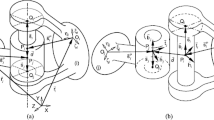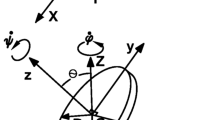Abstract
This paper is focused on the dynamic formulation of mechanical joints using different approaches that lead to different models with different numbers of degrees of freedom. Some of these formulations allow for capturing the joint deformations using a discrete elastic model while the others are continuum-based and capture joint deformation modes that cannot be captured using the discrete elastic joint models. Specifically, three types of joint formulations are considered in this investigation; the ideal, compliant discrete element, and compliant continuum-based joint models. The ideal joint formulation, which does not allow for deformation degrees of freedom in the case of rigid body or small deformation analysis, requires introducing a set of algebraic constraint equations that can be handled in computational multibody system (MBS) algorithms using two fundamentally different approaches: constrained dynamics approach and penalty method. When the constrained dynamics approach is used, the constraint equations must be satisfied at the position, velocity, and acceleration levels. The penalty method, on the other hand, ensures that the algebraic equations are satisfied at the position level only. In the compliant discrete element joint formulation, no constraint conditions are used; instead the connectivity conditions between bodies are enforced using forces that can be defined in their most general form in MBS algorithms using bushing elements that allow for the definition of general nonlinear forces and moments. The new compliant continuum-based joint formulation, which is based on the finite element (FE) absolute nodal coordinate formulation (ANCF), has several advantages: (1) It captures modes of joint deformations that cannot be captured using the compliant discrete joint models; (2) It leads to linear connectivity conditions, thereby allowing for the elimination of the dependent variables at a preprocessing stage; (3) It leads to a constant inertia matrix in the case of chain like structure; and (4) It automatically captures the deformation of the bodies using distributed inertia and elasticity. The formulations of these three different joint models are compared in order to shed light on the fundamental differences between them. Numerical results of a detailed tracked vehicle model are presented in order to demonstrate the implementation of some of the formulations discussed in this investigation.


















Similar content being viewed by others
References
Bando, K., Yoshida, K., Hori, K.: The development of the rubber track for small size bulldozers. In: International Off-Highway & Powerplants Congress & Exposition, Milwaukee, WI (1991)
Bayoumy, A.H., Nada, A.A., Megahed, S.M.: A continuum based three-dimensional modeling of wind turbine blades. J. Comput. Nonlinear Dyn. (2012). doi:10.1115/1.4007798
Choi, J.H., Lee, H.C., Shabana, A.A.: Spatial dynamics of multibody tracked vehicles. Veh. Syst. Dyn. 29, 27–49 (1998)
Galaitsis, A.G.: A model for predicting dynamic track loads in military vehicles. J. Vib. Acoust. Stress Reliab. Des. 106, 286–291 (1984)
Gantoi, F.M., Shabana, A.A., Brown, M.A.: Finite element modeling of the contact geometry and deformation in biomechanics applications. J. Comput. Nonlinear Dyn. (2013). doi:10.1115/1.4024541
Gerstmayr, J., Shabana, A.A.: Analysis of thin beams and cables using the absolute nodal coordinate formulation. Nonlinear Dyn. 45, 109–130 (2006)
Gerstmayr, J., Sugiyama, H., Mikkola, A.: Review on the absolute nodal coordinate formulation for large deformation analysis of multibody systems. J. Comput. Nonlinear Dyn. (2013). doi:10.1115/1.4023487
M113: Image, A Troop 4/12 CAV, 2003, Web, 11 July 2012, http://www.atroop412cav.com/tools/ACAV/images/M113-drawing.gif
M113 vehicle family rubber track installation instructions: Litho’d, in Canada, 2003, 16 July 2012. www.combatreform.org/SoucyBandTrackInstallationA-654RB.pdf
Mohamed, A.A.: Three-dimensional fully parameterized triangular plate element based on the absolute nodal coordinate formulation. J. Comput. Nonlinear Dyn. (2013). doi:101115/1.4024729
Murray, M., Canfield, T.R.: Modeling of a flexible link power transmission system. In: Proceedings of the 6th ASME International Power Transmission and Gearing Conference, Scottsdale, Arizona (1992)
Nachbagauer, K., Gerstmayr, J., Gruber, P.: Structural and continuum mechanics approaches for a 3D shear deformable ANCF beam finite element: application to static and linearlized dynamic examples. J. Comput. Nonlinear Dyn. (2012). doi:10.1115/1.4006787
Nakanishi, T., Shabana, A.A.: Contact forces in the nonlinear dynamic analysis of tracked vehicles. Int. J. Numer. Methods Eng. 37, 1251–1275 (1994)
Ozaki, T., Shabana, A.A.: Treatment of constraints in multibody systems. Part I: methods of constrained dynamics. Int. J. Multiscale Comput. Eng. 1, 235–252 (2003)
Ozaki, T., Shabana, A.A.: Treatment of constraints in multibody systems. Part II: application to tracked vehicles. Int. J. Multiscale Comput. Eng. 1, 253–276 (2003)
Roberson, R.E., Schertassek, R.: Dynamics of Multibody Systems. Springer, Berlin (1988)
Rubinstein, D., Hitron, R.: A detailed multi-body model for dynamic simulation of off-road tracked vehicles. J. Terramech. 41, 163–173 (2004)
Ryu, H.S., Bae, D.S., Choi, J.H., Shabana, A.A.: A compliant track link model for high-speed, high-mobility tracked vehicles. Int. J. Numer. Methods Eng. 48, 1481–1502 (2000)
Ryu, H.S., Huh, K.S., Bae, D.S., Choi, J.H.: Development of a multibody dynamics simulation tool for tracked vehicles, part I: efficient contact and nonlinear dynamics modeling. JSME Int. J. 46(2), 540–549 (2003)
Shabana, A.A.: Computational Dynamics, 3rd edn. Wiley, New York (2010)
Shabana, A.A., Zaazaa, K.E., Sugiyama, H.: Railroad Vehicle Dynamics: A Computational Approach. Taylor & Francis/CRC, Boca Raton (2008)
Shabana, A.A., Hamed, A.M., Mohamed, A.A., Jayakumar, P., Letherwood, M.D.: Use of B-spline in the finite element analysis: comparison with ANCF geometry. J. Comput. Nonlinear Dyn. 7, 81–88 (2012)
Stanciulescu, I., Khude, N., Negrut, D., Melanz, D.: Efficient parallel simulation of large flexible body systems with multiple contacts. J. Comput. Nonlinear Dyn. (2013). doi:10.1115/1.4023915
Acknowledgements
This research was supported by the US Army Tank-Automotive Research, Development, and Engineering Center (TARDEC) (Contract No. W911NF-07-D-0001).
Author information
Authors and Affiliations
Corresponding author
Rights and permissions
About this article
Cite this article
Wallin, M., Aboubakr, A.K., Jayakumar, P. et al. A comparative study of joint formulations: application to multibody system tracked vehicles. Nonlinear Dyn 74, 783–800 (2013). https://doi.org/10.1007/s11071-013-1005-6
Received:
Accepted:
Published:
Issue Date:
DOI: https://doi.org/10.1007/s11071-013-1005-6




